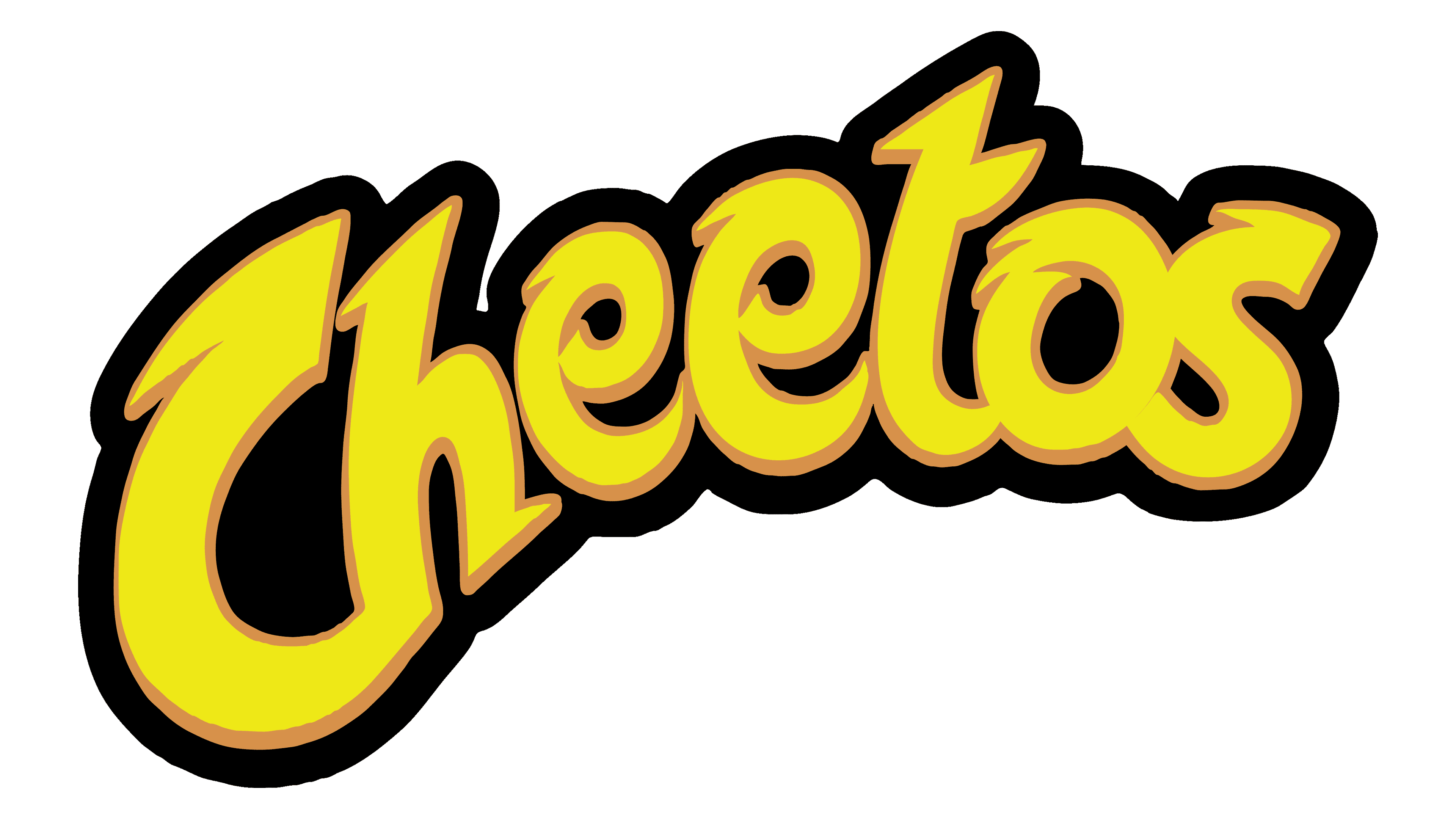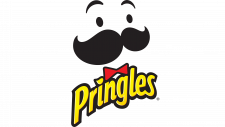Cheetos Logo
Cheetos is a popular brand of cheese-flavored puffed cornmeal snacks known for their distinctive orange color and playful mascot, Chester Cheetah. Currently, they are produced by Frito-Lay, a subsidiary of PepsiCo. Cheetos enjoys widespread popularity, with major markets in North America, Europe, Asia, and various other regions. Their products have diversified, including variations in flavor and texture, catering to a broad range of taste preferences. As part of PepsiCo, Cheetos benefits from extensive distribution channels, innovative marketing, and a loyal customer base. The brand often collaborates on limited-edition flavors and engages in creative advertising campaigns to maintain its strong market presence.
Meaning and history

The 1970s marked a significant era for Cheetos, with the snack achieving widespread popularity across America. The introduction of the brand’s iconic mascot, Chester Cheetah, in 1986, further enhanced its appeal. Chester, known for his suave personality and memorable catchphrase, “It’s not easy being cheesy,” became a staple of the brand’s identity.
Cheetos’ journey is marked by continual innovation. The 1990s witnessed the launch of various flavors and textures, most notably the Flamin’ Hot Cheetos, an invention of Richard Montañez, a janitor within Frito-Lay. This spicy variation of the classic snack garnered a massive following, particularly among the youth.
The turn of the century saw Cheetos’ expansion into international markets, including Europe and Asia. The brand has consistently tailored its products to match shifting consumer tastes, introducing healthier options like Baked Cheetos and experimenting with limited-edition flavors for those seeking new experiences.
Cheetos’ marketing strategies have been dynamic, embracing modern campaigns, active social media presence, and collaborations with celebrities and other brands. The brand has even forayed into fashion and culinary arts, with exclusive merchandise and pop-up culinary experiences featuring Cheetos-inspired dishes.
Presently, as a part of the PepsiCo family, Cheetos is valued as a multi-billion-dollar brand. Its evolution from a straightforward snack to a cultural symbol showcases an effective blend of product innovation, savvy marketing, and keen consumer insight. The story of Cheetos is more than just a snack’s history; it’s a testament to a brand’s ability to grow and resonate with diverse audiences while staying true to its original charm.
What is Cheetos?
Cheetos is a globally recognized brand of cheese-flavored snacks, famed for their distinctive orange hue and puffy, crunchy texture. Created by Frito-Lay, a PepsiCo subsidiary, these snacks are celebrated for their tangy, cheesy taste and are available in a variety of flavors, appealing to a wide array of taste preferences around the world.
1948 – 1963
The logo is striking in its simplicity, featuring the brand name “Cheetos” in a fluid, cursive script that conveys a sense of playfulness and informality. Set against a bold red background, the white lettering pops with contrast, making it instantly recognizable. The typography curves with an almost whimsical twist, particularly on the elongated ‘C’ that swoops in with confidence, and the ‘s’ that curls with a casual flair at the end, suggesting the brand’s lightheartedness. This design choice aligns with the snack’s fun and spirited nature, inviting consumers into a world of enjoyable snacking. The absence of additional imagery or detail keeps the focus on the brand name, ensuring it remains memorable and clearly identifiable.
1963 – 1981
This rendition of the Cheetos logo presents itself in a deep navy blue, a departure from the previous bright red. The brand name maintains its cursive flair but adopts a bolder, more substantial font that exudes a sense of robustness and stability. The letters are fuller and more pronounced, with a slight tilt that adds dynamism to the design. Notably, the background is absent, allowing the logo to stand out starkly against any backdrop it’s placed upon. The navy blue color choice is less common in snack branding, which may lend a unique sophistication to the playful snack. TThis evolution reflects a brand that respects its heritage while embracing a modern look, suggesting reliability and quality in its products.
1981 – 1995
This logo preserves the cursive flow of the “Cheetos” wordmark. The letters are interconnected smoothly, suggesting the seamless, enjoyable experience of snacking on Cheetos. The font’s weight is consistent, giving the logo a solid and assertive presence, while the serifs at the ends of certain letters have been minimized, lending a more contemporary and streamlined appearance.
1995 – 1998
The Cheetos logo displayed leaps forward with a dynamic, three-dimensional design, evoking a sense of movement and energy. Set against an angled black backdrop, the word “Cheetos” is rendered in a vibrant yellow with a bold white outline and a shadow effect that adds depth. This logo introduces the element “BRAND” in a smaller, straightforward font, contrasting with the playful cursive of the main script.
Compared to its predecessor, this logo embraces a more adventurous and modern aesthetic. The previous navy blue is replaced with a bright yellow, symbolizing the snack’s lively and fun nature. The addition of the black background with shadowing gives the impression that the logo could leap off the page, suggesting the excitement associated with the brand.
This iteration of the Cheetos logo marks a significant shift from the minimalistic and flat design to one that is more dynamic and visually engaging. The use of the drop shadow and the three-dimensional effect signifies the brand’s aim to stand out in a crowded market and to be seen as a leader in innovation and flavor.
1996 – 1998
In this rendition of the emblem, the font mimicked a scrawled hook style. The characters appeared to be scribbled quickly, a stark contrast to the elegance of fluid calligraphy. Arranged in a playful, uneven alignment, the letters gave off an impression of dynamic movement, almost as if they were leaping. This asymmetrical arrangement brought a subtle, intrinsic balance to the design, with the glyphs echoing an assortment of elongated, irregularly shaped treats scattered randomly. A slender, crimson outline hugged closely to the extremities of the letters, adding a delicate frame. Further enhancing this effect, the border of the encompassing ebony rectangle was artfully distorted, giving it a rugged, torn appearance. This artistic interplay of unorthodox typography and edgy design elements lent the logo a unique, avant-garde character, setting it apart from conventional designs. The rough, almost raw quality of the lettering, combined with the bold, contrasting colors, created a visual experience that was both striking and memorable. This innovative approach to logo design demonstrated a fearless embrace of unconventional aesthetics, challenging traditional notions of symmetry and uniformity in graphic design.
1998 – 2001
The logo is a dynamic and bold design that features a stylized, italicized font. The main text is a white, reminiscent of the snack’s signature color, capturing the essence of the brand’s identity. This hue is outlined by a thin vivid orange border, which then transitions into a thick, striking black shadow effect, giving the impression of depth and a three-dimensional appearance. The shadow itself is irregularly shaped, adding a sense of movement and energy, as if the logo is in motion. The first letter is capitalized and noticeably larger than the other letters, drawing attention and emphasizing the brand name. The text is slightly curved, further enhancing the sensation of action and liveliness. The combination of colors is contrasting, with the orange and black providing a visual pop that is instantly recognizable and associated with the brand. The overall design conveys a playful, upbeat vibe that aligns with the brand’s fun and youthful image.
2001 – Today
This logo is an effervescent and eye-catching design that consists of a bright, sun-kissed yellow font with a playful, cartoonish style. The text is plump and rounded, giving a friendly and approachable feel. Each letter is outlined with a thick black border that enhances its visibility and adds a striking contrast against the yellow. The font has a slight slant to the right, conveying a sense of forward momentum and energy. The letters are connected, suggesting a sense of unity and fun. There’s a shadow effect in black that trails the text, giving it a layered and three-dimensional effect. This shadow is not as pronounced as in the previous logo, but it still provides a solid grounding for the text above it.
Comparing it to the previous logo, there are several changes. The color scheme has shifted from an white-orange to a yellow, corresponding to a lighter and brighter look. The black shadow has been softened and is less jagged, which reduces the aggressive dynamism in favor of a more playful buoyancy. The font itself is less italicized and more upright, making it appear more stable and less in motion. The white outlining present in the previous logo is absent here, which simplifies the design and allows the yellow and black to stand out more starkly. Overall, this logo retains the spirit of the brand while presenting a more modern and streamlined appearance.

















